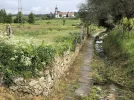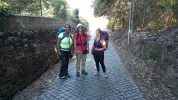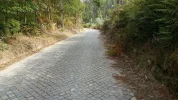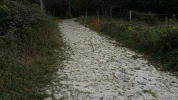doctorherman
Member
- Time of past OR future Camino
- Frances*3, Ingles, Primitivo, Finisterre, Baztan, and Portuguese
Hi,
I'm now in Porto after walking from Lisbon and my feet are really killing me like on no other Camino I've done. While seeing thousands of lovely gardens with their flowers in full bloom and lots of amazing garden statues, I'm not sure I can take much more asphalt. The towns of Santarem, Tomar, Coimbra and Golega are stunning in themselves. The section from Tomar to Coimbra was lovely.
Today I was even thinking how wonderful the section from Leon to Hospital de Orbigo was (the section I used to think was awful), on a comfortable pilgrim soft path.
I don't know how much more road and car dodging I can take, as well as saying Bon Dia to friendly villager after villager. I really think that if the Portuguese want to create a great Caminho route that will attract lots of people, they are going to have to find a much greater proportion of tracks and paths not made of asphalt. So far, the other pilgrims I have met, who have all been at least second timers on a Camino, have all said the same.
So, I have decided I have 2 options for the rest of my time this year. 1. Continue. 2. Get to Astorga and get on the Frances.
So I have a rest day tomorrow and will decide? Does it get easier on the feet and nerves? Is the section from Porto more of the same or are there more non asphalt paths that allow for introspection rather than foot pain and car dodging?
Thanks for any advice.
I'm now in Porto after walking from Lisbon and my feet are really killing me like on no other Camino I've done. While seeing thousands of lovely gardens with their flowers in full bloom and lots of amazing garden statues, I'm not sure I can take much more asphalt. The towns of Santarem, Tomar, Coimbra and Golega are stunning in themselves. The section from Tomar to Coimbra was lovely.
Today I was even thinking how wonderful the section from Leon to Hospital de Orbigo was (the section I used to think was awful), on a comfortable pilgrim soft path.
I don't know how much more road and car dodging I can take, as well as saying Bon Dia to friendly villager after villager. I really think that if the Portuguese want to create a great Caminho route that will attract lots of people, they are going to have to find a much greater proportion of tracks and paths not made of asphalt. So far, the other pilgrims I have met, who have all been at least second timers on a Camino, have all said the same.
So, I have decided I have 2 options for the rest of my time this year. 1. Continue. 2. Get to Astorga and get on the Frances.
So I have a rest day tomorrow and will decide? Does it get easier on the feet and nerves? Is the section from Porto more of the same or are there more non asphalt paths that allow for introspection rather than foot pain and car dodging?
Thanks for any advice.



























